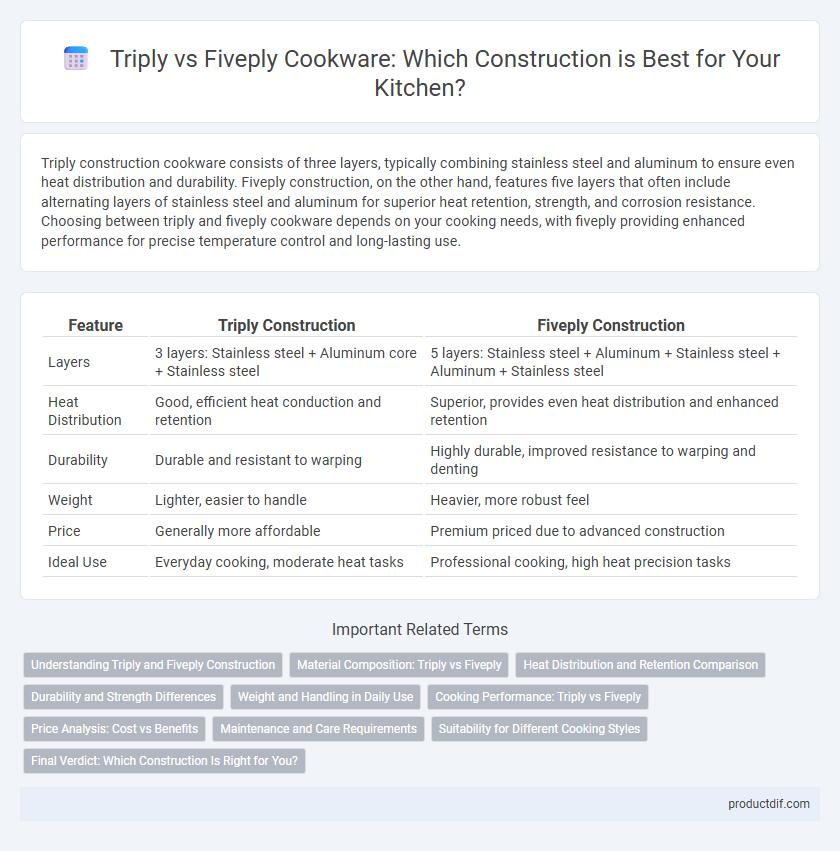Triply construction cookware consists of three layers, typically combining stainless steel and aluminum to ensure even heat distribution and durability. Fiveply construction, on the other hand, features five layers that often include alternating layers of stainless steel and aluminum for superior heat retention, strength, and corrosion resistance. Choosing between triply and fiveply cookware depends on your cooking needs, with fiveply providing enhanced performance for precise temperature control and long-lasting use.
Table of Comparison
| Feature | Triply Construction | Fiveply Construction |
|---|---|---|
| Layers | 3 layers: Stainless steel + Aluminum core + Stainless steel | 5 layers: Stainless steel + Aluminum + Stainless steel + Aluminum + Stainless steel |
| Heat Distribution | Good, efficient heat conduction and retention | Superior, provides even heat distribution and enhanced retention |
| Durability | Durable and resistant to warping | Highly durable, improved resistance to warping and denting |
| Weight | Lighter, easier to handle | Heavier, more robust feel |
| Price | Generally more affordable | Premium priced due to advanced construction |
| Ideal Use | Everyday cooking, moderate heat tasks | Professional cooking, high heat precision tasks |
Understanding Triply and Fiveply Construction
Triply construction cookware features three layers, typically consisting of an aluminum core sandwiched between stainless steel, offering efficient heat distribution and durability. Fiveply construction enhances this by incorporating five alternating layers of stainless steel and aluminum, which improves heat retention, prevents warping, and provides superior cooking performance. Understanding the difference between triply and fiveply construction helps in choosing cookware that balances durability, heat conductivity, and price based on cooking needs.
Material Composition: Triply vs Fiveply
Triply construction features three layers usually composed of stainless steel, aluminum, and stainless steel, providing balanced heat distribution and durability. Fiveply construction incorporates five alternating layers often combining stainless steel, aluminum, and sometimes copper for enhanced heat conductivity and improved cooking performance. The additional layers in fiveply cookware create superior temperature control and resistance to warping compared to triply counterparts.
Heat Distribution and Retention Comparison
Triply construction cookware typically features three layers, usually aluminum sandwiched between stainless steel, offering good heat distribution and moderate retention ideal for everyday cooking. Fiveply construction incorporates five layers, often combining stainless steel and aluminum with an added layer of copper or more aluminum, enhancing heat conduction and significantly improving heat retention for precise temperature control. The increased layering in fiveply cookware promotes even heating and superior heat retention, making it more efficient for slow cooking and searing compared to triply cookware.
Durability and Strength Differences
Triply cookware typically consists of three layers: an aluminum core sandwiched between two stainless steel layers, providing good heat conductivity and moderate durability. Fiveply construction features five layers, alternating stainless steel and aluminum, delivering superior strength, enhanced durability, and more even heat distribution. The extra layers in fiveply cookware reduce warping and improve overall longevity compared to triply construction.
Weight and Handling in Daily Use
Triply cookware typically features three layers of metal, reducing overall weight and enhancing ease of handling during daily cooking tasks. Fiveply construction incorporates five metal layers, increasing durability and heat distribution but adding noticeable weight that may affect maneuverability. Users seeking lightweight, easily handled pots and pans often prefer triply options, while those prioritizing heat retention and longevity might opt for fiveply despite the extra heft.
Cooking Performance: Triply vs Fiveply
Triply construction cookware features three bonded layers, typically combining stainless steel with an aluminum core, offering efficient heat distribution and good durability for everyday cooking. Fiveply construction includes five layers, often alternating stainless steel and aluminum, providing superior heat retention, more even heat distribution, and enhanced cooking control. The increased layering in fiveply cookware results in better temperature stability and responsiveness, making it ideal for precise cooking techniques compared to triply options.
Price Analysis: Cost vs Benefits
Triply construction cookware typically offers a more affordable price point due to fewer metal layers, making it suitable for budget-conscious consumers seeking basic heat distribution. Fiveply construction, with its multiple metal layers including stainless steel and aluminum, provides superior heat retention and even cooking, justifying its higher cost through enhanced durability and culinary performance. Investing in fiveply cookware often results in long-term savings by reducing energy use and improving cooking precision, outweighing the initial price difference compared to triply alternatives.
Maintenance and Care Requirements
Triply cookware features three layers, typically aluminum sandwiched between stainless steel, offering straightforward maintenance with ease of cleaning and resistance to warping. Fiveply construction includes five alternating layers of stainless steel and aluminum, providing enhanced heat distribution but may require more careful cleaning to avoid damage to the multiple bonded layers. Both types are dishwasher safe, but hand washing and using non-abrasive tools extend the lifespan, especially for fiveply cookware due to its complex structure.
Suitability for Different Cooking Styles
Triply cookware features a three-layer construction with an aluminum core bonded between two stainless steel layers, offering rapid heat conduction ideal for everyday cooking and moderate heat settings. Fiveply construction incorporates five layers of alternating stainless steel and aluminum, providing superior heat retention and even distribution suited for high-heat searing, frying, and precise temperature control. Chefs who frequently perform tasks requiring quick temperature changes or gentle simmering benefit more from triply cookware, while those engaged in professional or intensive cooking techniques often prefer the robustness of fiveply cookware.
Final Verdict: Which Construction Is Right for You?
Triply construction offers lightweight cookware with excellent heat conduction, ideal for everyday cooking and quick temperature changes. Fiveply construction provides superior durability, even heat distribution, and enhanced heat retention, making it perfect for professional chefs or those seeking long-lasting performance. Choose triply for affordability and ease of handling, while fiveply suits users prioritizing robust build and consistent cooking results.
Triply Construction vs Fiveply Construction Infographic

 productdif.com
productdif.com